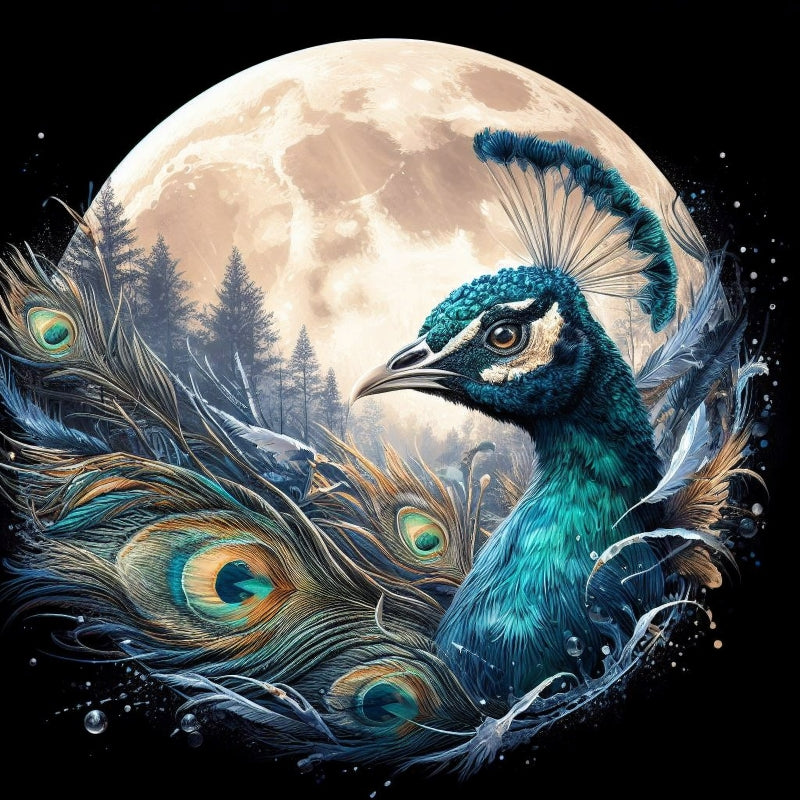
Top 10 Interesting Facts About Indian Peacocks
Share
The Indian peacock, scientifically known as Pavo cristatus, is a bird that captivates hearts with its vibrant plumage and graceful movements. As the national bird of India, it holds a special place in the cultural and ecological landscape of the country. This blog post will explore ten fascinating facts about Indian peacocks, highlighting their unique characteristics, cultural significance, and ecological roles.
- National Bird of India
The Indian peacock was declared the national bird of India in 1963 due to its rich cultural significance and widespread presence across the country. The decision to designate the peacock as the national bird was made because it is easily recognizable and has been associated with Indian traditions for centuries. Its vibrant colors and majestic appearance symbolize the beauty and diversity of India's wildlife.
- Sexual Dimorphism
One of the most striking features of Indian peacocks is sexual dimorphism, where males and females exhibit different physical characteristics. Male peacocks are renowned for their spectacular iridescent plumage, characterized by brilliant blue and green hues adorned with eye-like patterns known as ocelli. In contrast, female peafowls, or peahens, have more subdued brown and gray plumage that helps them camouflage in their natural habitats. This difference not only aids in mating displays but also serves as a survival mechanism for the females during nesting.
- Courtship Displays
During mating season, male peacocks perform elaborate courtship displays to attract females. They fan out their long tail feathers and shake them to create a mesmerizing visual spectacle. The display is accompanied by distinctive calls and movements designed to showcase their vibrant colors and impressive size. Research indicates that female peafowls are selective in choosing mates based on the quality of the male's plumage, particularly the number of eyespots on their tail feathers.
- Diet and Feeding Habits
Indian peacocks are omnivorous birds that feed on a diverse diet consisting of seeds, fruits, insects, small mammals, and reptiles. Their feeding habits play a crucial role in controlling insect populations and contributing to seed dispersal within their habitats. Peafowls are often seen foraging in open grasslands, agricultural fields, and forest edges, where they can find ample food sources.
- Habitat Preferences
Peacocks are adaptable birds found in a variety of habitats across India, including forests, grasslands, scrublands, and even urban areas. They prefer areas with nearby water sources where they can forage for food while avoiding predators. Their ability to thrive in diverse environments has contributed to their widespread distribution throughout the Indian subcontinent.
- Cultural Significance
The Indian peacock holds immense cultural importance in India and is often associated with various deities in Hindu mythology. For instance, Lord Krishna is frequently depicted wearing a crown adorned with peacock feathers, symbolizing beauty and grace. Additionally, the peacock is linked to several festivals celebrated across India; its dance during the monsoon season is seen as an auspicious sign of fertility and prosperity. Peacocks have also inspired countless works of art throughout history. From intricate carvings in temples to motifs on textiles, they have become symbols of elegance and artistic expression in Indian culture.
- Conservation Status
While the Indian peacock is currently classified as "Least Concern" by the International Union for Conservation of Nature (IUCN), it faces several threats that could impact its populations:
- Habitat Loss: Urbanization and agricultural expansion have led to significant habitat destruction for many wildlife species, including peafowls. As forests are cleared for development or agriculture, these birds lose their natural habitats.
- Human-Wildlife Conflict: As human populations grow near peafowl habitats; conflicts arise when these birds raid crops or gardens in search of food. Farmers may retaliate against these birds to protect their livelihoods.
Despite these challenges, conservation efforts have been implemented to protect Indian peafowls through legal protections under the Wildlife Protection Act of 1972.
- Lifespan and Reproduction
The average lifespan of an Indian peacock in the wild ranges from 10 to 25 years, depending on environmental conditions and predation risks. During mating season, female peafowls typically lay between 4 to 8 eggs, which are incubated for about 28 days before hatching. The young chicks are precocial; they can walk shortly after hatching and quickly learn to forage for food under the watchful eye of their mother.
- Symbolism in Modern Culture
In contemporary society, the Indian peacock continues to be celebrated as a symbol of beauty and grace:
- Tourism: Peafowls attract tourists to national parks and wildlife sanctuaries where they can be observed in their natural habitats. Birdwatching tours often highlight these magnificent creatures as part of India's rich wildlife offerings.
- Media Representation: The image of the peacock is commonly used in advertisements, films, and fashion shows to evoke feelings of elegance and cultural pride. Its association with beauty makes it an appealing motif for various forms of media.
- Educational Importance
The Indian peacock serves an educational purpose beyond its aesthetic appeal:
- Wildlife Education: Schools and educational programs use the peacock as a focal point for teaching students about biodiversity conservation and environmental stewardship. By learning about this national symbol, students gain an appreciation for wildlife protection efforts.
- Cultural Awareness: Understanding the significance of the peacock helps foster respect for India's diverse cultural heritage while promoting awareness about traditional practices that honor nature.
Conclusion
The Indian peacock is more than just a beautiful bird; it embodies a rich tapestry of history, culture, spirituality, and ecological importance within India. Revered as symbols of beauty and grace across various traditions—peacocks continue to inspire awe among people from all walks of life.
Understanding these ten fascinating facts about Indian peacocks not only deepens our appreciation for them but also highlights the importance of preserving their habitats for future generations. By fostering coexistence strategies that benefit both humans and wildlife—such as securing corridors for movement—we can ensure that these iconic birds continue to thrive amidst changing landscapes.
As we celebrate this national symbol—may we also honor our responsibility toward conserving nature for future generations while fostering coexistence strategies that benefit both humans and wildlife alike!
Citations:
[1] https://www.nathab.com/know-before-you-go/asia-the-pacific/india/wildlife-guide/indian-peafowl/
[2] https://byjus.com/free-ias-prep/interesting-facts-about-national-bird-of-india/
[3] https://www.treehugger.com/peacock-facts-5094142
[4] https://www.natureinfocus.in/animals/all-about-the-indian-peafowl
[5] https://owlcation.com/stem/The-Proud-Peackcock-Eight-Fun-Facts-on-the-Indian-Peacock
